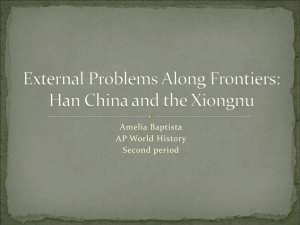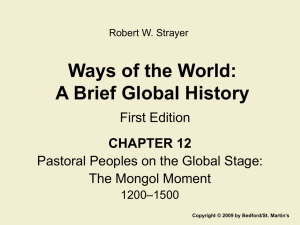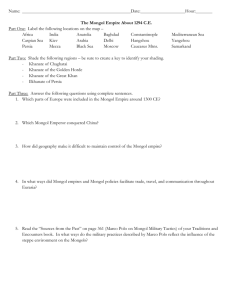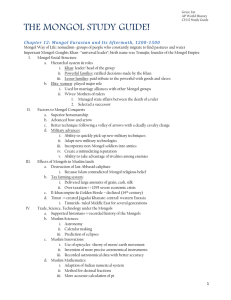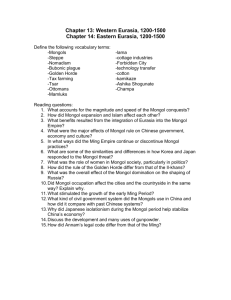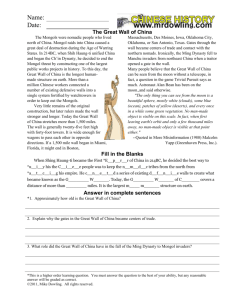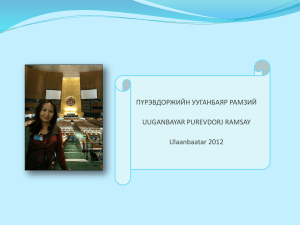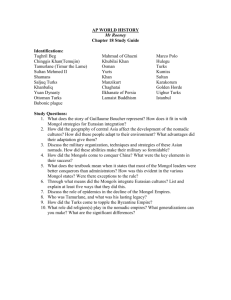Health of Xiongnu and Mongol period populations: a bioarchaeological analysis... populations from two ancient Mongolian empires
advertisement
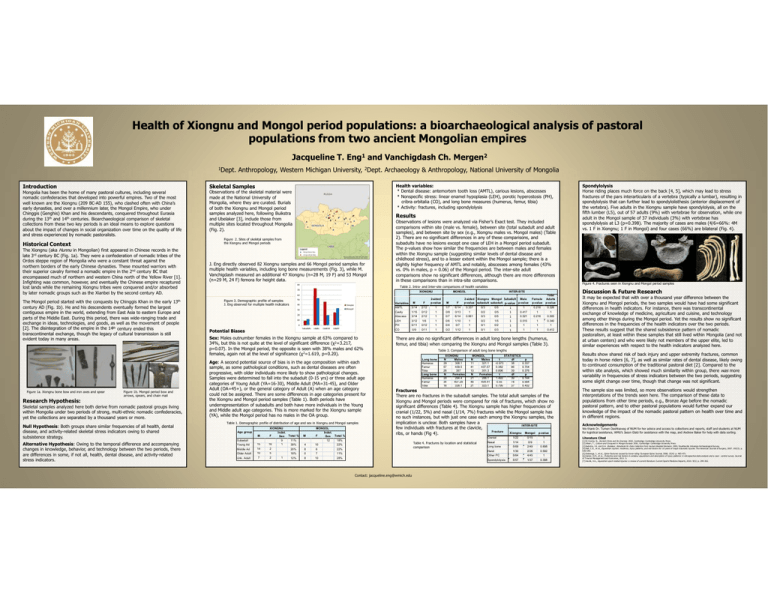
Health of Xiongnu and Mongol period populations: a bioarchaeological analysis of pastoral populations from two ancient Mongolian empires Jacqueline T. Eng1 and Vanchigdash Ch. Mergen2 1Dept. Dept Skeletal Samples Introduction Mongolia has been the home of many pastoral cultures, including several nomadic confederacies that developed into powerful empires. Two of the most well known are the Xiongnu (209 BC-AD 155), who clashed often with China’s early dynasties, and over a millennium later, the Mongol Empire, who under Chinggis (Genghis) Khan and his descendants, conquered throughout Eurasia during the 13th and 14th centuries. Bioarchaeological comparison of skeletal collections from these two key periods is an ideal means to explore questions about the impact of changes in social organization over time on the quality of life and stress experienced by nomadic pastoralists. Historical Context The Xiongnu (aka Hunnu in Mongolian) first appeared in Chinese records in the late 3rd century BC (Fig. 1a). They were a confederation of nomadic tribes of the Ordos steppe region of Mongolia who were a constant threat against the northern borders of the early Chinese dynasties. These mounted warriors with their superior cavalry formed a nomadic empire in the 2nd century BC that encompassed much of northern and western China north of the Yellow River [1]. Infighting was common, however, and eventually the Chinese empire recaptured lost lands while the remaining Xiongnu tribes were conquered and/or absorbed by later nomadic groups such as the Xianbei by the second century AD. The Mongol period started with the conquests by Chinggis Khan in the early 13th century AD (Fig. 1b). He and his descendents eventually formed the largest contiguous empire in the world, extending from East Asia to eastern Europe and parts of the Middle East. During this period, there was wide-ranging trade and exchange in ideas, technologies, and goods, as well as the movement of people [2]. The disintegration of the empire in the 14th century ended this transcontinental exchange, though the legacy of cultural transmission is still evident today in many areas. Figure 1a. Xiongnu bone bow and iron axes and spear Research Hypothesis: Anthropology, Anth opolog Western Weste n Michigan University, Uni e sit 2Dept Dept. Archaeology A chaeolog & Anthropology, Anth opolog National University Uni e sit of Mongolia Figure 1b. Mongol period bow and arrows, spears, and chain mail Skeletal samples analyzed here both derive from nomadic pastoral groups living within Mongolia under two periods of strong, multi-ethnic nomadic confederacies, yet the collections are separated by a thousand years or more. Null Hypothesis: Both groups share similar frequencies of all health, dental disease, and activity-related skeletal stress indicators owing to shared subsistence strategy. Alternative Hypothesis: Owing to the temporal difference and accompanying changes in knowledge, behavior, and technology between the two periods, there are differences in some, if not all, health, dental disease, and activity-related stress indicators. Health variables: * Dental disease: antemortem tooth loss (AMTL), carious lesions, abscesses * Nonspecific stress: linear enamel hypoplasia (LEH), porotic hyperostosis (PH), cribra orbitalia (CO), and long bone measures (humerus, femur, tibia) * Activity: fractures, including spondylolysis Observations of the skeletal material were made at the National University of Mongolia, where they are curated. Burials of both the Xiongnu and Mongol period samples analyzed here, following Buikstra and Ubelaker [3], include those from multiple sites located throughout Mongolia (Fig. 2). Results Figure 2. Sites of skeletal samples from the Xiongnu and Mongol periods J. Eng directly observed 82 Xiongnu samples and 66 Mongol period samples for multiple health variables, including long bone measurements (Fig. 3), while M. Vanchigdash measured an additional 47 Xiongnu (n=28 M, 19 F) and 53 Mongol (n=29 M, 24 F) femora for height data. Observations of lesions were analyzed via Fisher’s Exact test. They included comparisons within site (male vs. female), between site (total subadult and adult samples) and between site by sex (e.g., samples), (e g Xiongnu males vs vs. Mongol males) (Table 2). There are no significant differences in any of these comparisons, and subadults have no lesions except one case of LEH in a Mongol period subadult. The p-values show how similar the frequencies are between males and females within the Xiongnu sample (suggesting similar levels of dental disease and childhood stress), and to a lesser extent within the Mongol sample; there is a slightly higher frequency of AMTL and notably, abscesses among females (43% vs. 0% in males, p = 0.06) of the Mongol period. The inter-site adult comparisons show no significant differences, although there are more differences in these comparisons than in intra-site comparisons. Table 2. Intra- and Inter-site comparisons of health variables XIONGNU MONGOL INTER-SITE 2-sided Xiongnu Mongol Subadult Male p-value subadult subadult p‐value p-value Female p-value Total Adults p-value M F 2-sided p-value M F AMTL 3/14 2/12 1 1/7 6/14 0.337 0/3 0/5 Cavity 1/15 0/12 1 0/8 0/13 1 0/2 0/5 Abscess 3/14 2/12 1 0/7 6/14 0.061 0/3 0/5 LEH 3/12 1/6 1 0/6 1/10 1 0/2 1/5 PH 0/11 0/12 1 0/4 0/7 1 0/1 0/2 Potential Biases CO 0/9 0/11 1 0/2 1/12 1 0/1 0/3 Sex: Males outnumber females in the Xiongnu sample at 63% compared to 34%, but this is not quite at the level of significant difference (χ2=3.217, p=0.07). In the Mongol period, the opposite is seen with 38% males and 62% females, again not at the level of significance (χ2=1.619, p=0.20). There are also no significant differences in adult long bone lengths (humerus, femur, and tibia) when comparing the Xiongnu and Mongol samples (Table 3). Figure 3. Demographic profile of samples J. Eng observed for multiple health indicators Variables Age: A second potential source of bias is in the age composition within each sample, as some pathological conditions, such as dental diseases are often progressive, with older individuals more likely to show pathological changes. Samples were determined to fall into the subadult (0-15 yrs) or three adult age categories of Young Adult (YA=16-30), Middle Adult (MA=31-45), and Older Adult (OA=45+), or the general category of Adult (A) when an age category could not be assigned. There are some differences in age categories present for the Xiongnu and Mongol period samples (Table 1). Both periods have underrepresentation of subadults and both have more individuals in the Young and Middle adult age categories. This is more marked for the Xiongnu sample (YA), while the Mongol period has no males in the OA group. Table 1. Demographic g p profile p of distribution of age g and sex in Xiongnu g and Mongol g samples p Age group M Subadult XIONGNU Indet. F Sex Total % 9 11% 16 1 39% 2 20% Young Ad 15 Middle Ad 14 Older Adult 10 5 Unk. Adult 7 2 1 MONGOL Indet. Sex Total % 12 18% M F 4 10 22% 8 6 22% 18% 0 7 11% 12% 8 10 28% 1 1 1 1 1 1 1 0.216 0.326 0.417 1 1 0.521 0.216 0.505 0.515 1 0.340 1 1 1 1 1 0.412 Table 3. Comparison of adult long bone lengths Long bone Humerus Femur Tibia Long bone Humerus Femur Tibia XIONGNU N Males 29 308.1 57 439.5 28 357 N Females 20 294.4 34 407.28 18 328.1 MONGOL N Males 11 321.1 41 437.57 13 351.3 N Females 21 288.1 46 404.41 21 323.1 t -0.973 0.382 0.896 t 1.492 0.55 0.795 STATISTICS df 38 96 39 df 39 78 37 Table 4. Fractures by location and statistical comparison Contact: jacqueline.eng@wmich.edu 1/22 0/15 Figure 4. Fractures seen in Xiongnu and Mongol period samples Discussion & Future Research It may b be expected t d th thatt with ith over a thousand th d year difference diff b between t th the Xiongnu and Mongol periods, the two samples would have had some significant differences in health indicators. For instance, there was transcontinental exchange of knowledge of medicine, agriculture and cuisine, and technology among other things during the Mongol period. Yet the results show no significant differences in the frequencies of the health indicators over the two periods. These results suggest that the shared subsistence pattern of nomadic pastoralism, at least within these samples that still lived within Mongolia (and not at urban centers) and who were likely not members of the upper elite, led to similar experiences with respect to the health indicators analyzed here. Results show shared risk of back injury and upper extremity fractures, common today in horse riders [6, [6 7], 7] as well as similar rates of dental disease, disease likely owing to continued consumption of the traditional pastoral diet [2]. Compared to the within site analysis, which showed much similarity within group, there was more variability in frequencies of stress indicators between the two periods, suggesting some slight change over time, though that change was not significant. p 0.337 0.704 0.376 p 0.144 0.584 0.432 Fractures There are no fractures in the subadult samples. The total adult samples of the Xiongnu and Mongol periods were compared for risk of fractures, which show no significant differences (Table 4). The Xiongnu sample has higher frequencies of cranial (1/22, 5%) and nasal (1/14, 7%) fractures while the Mongol sample has no such instances, but with just one case each among the Xiongnu samples, the implication p is unclear. Both samples p have a INTER-SITE few individuals with fractures at the clavicle, Fracture Xiongnu Mongol p-value ribs, or hands (Fig 4). Cranial Spondylolysis Horse riding places much force on the back [4, 5], which may lead to stress fractures of the pars interarticularis of a vertebra (typically a lumbar), resulting in spondylolysis that can further lead to spondylolisthesis (anterior displacement of the vertebra). Five adults in the Xiongnu sample have spondylolysis, all on the fifth lumber (L5), out of 57 adults (9%) with vertebrae for observation, while one adult in the Mongol sample of 37 individuals (3%) with vertebrae has spondylolysis at L3 (p=0.398). The majority of cases are males (4/6=66%: 4M vs. 1 F in Xiongnu; 1 F in Mongol) and four cases (66%) are bilateral (Fig. 4). 1 Nasal 1/14 0/9 1 Long bone 5/69 2/49 0.698 Hand 1/30 2/26 0.592 Other PC 5/64 4/45 1 Spondylolysis 5/57 1/37 0.398 The sample size was limited, so more observations would strengthen interpretations of the trends seen here. The comparison of these data to populations from other time periods, e.g., Bronze Age before the nomadic pastoral pattern, and to other pastoral populations would further expand our knowledge of the impact of the nomadic pastoral pattern on health over time and in different regions. A k Acknowledgements l d t We thank Dr. Tumen Dashtseveg of NUM for her advice and access to collections and reports, staff and students at NUM for logistical assistance, WMU’s Jason Glatz for assistance with the map, and Andrew Baker for help with data sorting. Literature Cited [1] Di Cosmo, N., Ancient China and Its Enemies. 2002, Cambridge: Cambridge University Press. [2] Allsen, T., Culture and Conquest in Mongol Eurasia. 2001, Cambridge: Cambridge University Press. [3] Buikstra, J.E. and D.H. Ubelaker, Standards for Data Collection from Human Skeletal Remains. 1994, Fayetteville: Arkansas Archaeological Survey. [4] Ball, C.G., et al., Equestrian injuries: incidence, injury patterns, and risk factors for 10 years of major traumatic injuries. The American Journal of Surgery, 2007. 193(5): p. 636-640. [5] Siebenga, J., et al., Spine fractures caused by horse riding. European Spine Journal, 2006. 15(4): p. 465-471. [6] Halser, R.M., et al., Protective and risk factors in amateur equestrians and description of injury patterns: A retrospective data analysis and a case - control survey. Journal of Trauma Management and Outcomes, 2011. 5. [7] Havlik, H.S., Equestrian sport-related injuries: a review of current literature. Current Sports Medicine Reports, 2010. 9(5): p. 299-302.
